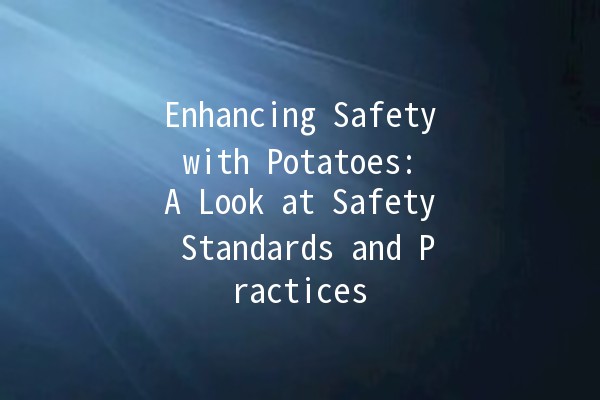: With the growing popularity of potatoes in various culinary settings, understanding their safety standards becomes essential. This article will delve into the safety practices surrounding potatoes, from farm to table, providing practical tips and insights for consumers and producers alike.
The Importance of Potato Safety
Potatoes are among the most consumed foods worldwide. However, ensuring their safety remains a critical concern. Risks can arise from improper handling, storage, and preparation. Understanding the importance of potato safety helps consumers make informed decisions about their food choices.
Common Risks Associated with Potatoes

Best Practices for Ensuring Potato Safety
To mitigate these risks and enhance safety measures for potatoes, several practical tips can be employed.
Practical Tips to Enhance Potato Safety
Washing potatoes correctly can eliminate contaminants and reduce health risks. Here’s how:
Rinse Under Cold Water: Place potatoes under cold running water and use a vegetable scrub brush to clean the surface. Avoid using soap or bleach, as these substances can leave harmful residues.
Remove Eyes and Bruises: Inspect potatoes for any eyes or bruises. These areas can harbor bacteria, so make sure to cut them away before cooking.
Application Example: Before making mashed potatoes, ensure all potatoes are thoroughly washed and any damaged sections are removed to enhance safety.
Storing potatoes in the right environment is crucial for maintaining their quality and safety.
Cool, Dark Place: Store potatoes in a cool, dark place, ideally between 45°F to 50°F (7°C to 10°C). Avoid areas exposed to sunlight or bright artificial light, which can cause them to sprout or turn green.
Avoid Refrigeration: Do not store potatoes in the refrigerator, as cold temperatures can convert starches into sugars, affecting taste and texture.
Application Example: A pantry away from heat sources is ideal for potato storage. Use breathable bags or crates to prevent moisture buildup, which can cause rot.
Proper cooking techniques play a vital role in ensuring potatoes are safe to eat.
Cook Thoroughly: Potatoes should be cooked to at least 165°F (74°C) to eliminate potential pathogens. This applies to baked, boiled, or fried potatoes.
Avoid CrossContamination: Use separate cutting boards and utensils for raw potatoes and other food items, particularly raw meats, to prevent crosscontamination.
Application Example: When preparing a potato salad, boil potatoes thoroughly before adding them to other ingredients, ensuring all components have been cooked properly.
Knowing how to identify spoiled potatoes can prevent health risks.
Signs of Spoilage: Inspect for an off smell, softness, or mold. Discoloration, especially green patches, indicates the presence of solanine, a toxic compound produced when potatoes are exposed to light.
Safe Disposal: If potatoes show any spoilage signs, dispose of them immediately to avoid any potential health risks.
Application Example: Before baking potatoes, examine them carefully for any green spots or signs of spoilage. Discard any compromised potatoes.
Recognizing the potential for chemical residues on potatoes is important for healthconscious consumers.
Choosing Organic: Opting for organic potatoes can minimize exposure to pesticide residues. Organic potatoes typically have fewer chemical treatments than conventional ones.
Peeling Potatoes: Peeling potatoes can also help eliminate any residues present on the skin, although this might result in losing some nutrients.
Application Example: For dishes where texture and appearance matter, like scalloped potatoes, consider peeling organic potatoes to enhance safety without compromising aesthetic appeal.
Frequently Asked Questions About Potato Safety
Symptoms of potato toxicity usually arise from consuming green or sprouted potatoes. These can include nausea, vomiting, abdominal pain, and, in severe cases, neurological symptoms. If you suspect potato toxicity, seek medical attention immediately.
Leftover cooked potatoes should be cooled to room temperature and stored in an airtight container in the refrigerator. Consume leftovers within three to five days to ensure safety.
Yes, potatoes can harbor bacteria, especially if handled improperly. Always wash hands and surfaces before and after handling potatoes, and ensure they are cooked to a safe temperature.
It is not safe to eat potatoes with green spots, as this indicates the presence of solanine, which is toxic. Always cut away green areas before cooking or discard the potato altogether.
The best way to prepare potatoes is to wash them thoroughly, remove any blemishes, cook them until they reach an internal temperature of 165°F (74°C), and avoid crosscontamination in the kitchen.
To prevent sprouting, store potatoes in a cool, dark place, away from other fruits that emit ethylene gas, which accelerates sprouting. Check potatoes regularly and use them before they sprout.
Ensuring the safety of potatoes involves several steps, from proper washing and storage to cooking techniques and recognizing spoilage. By following these practices, consumers can enjoy this versatile and delicious vegetable while minimizing health risks. Potatoes are a great addition to many meals, and understanding their safety can enhance culinary experiences while maintaining health standards.